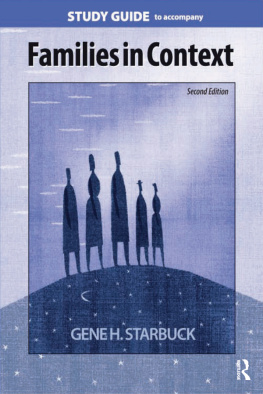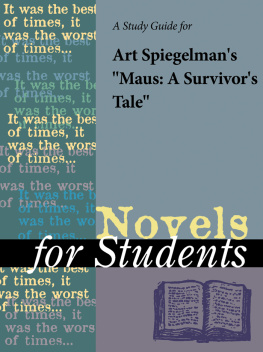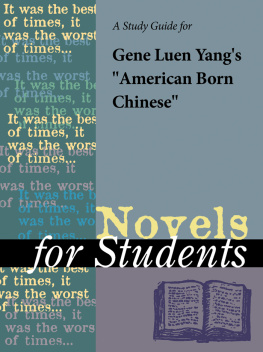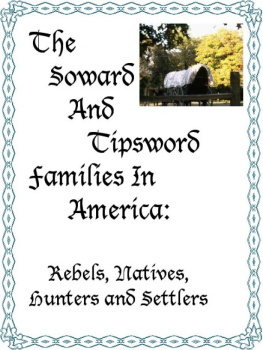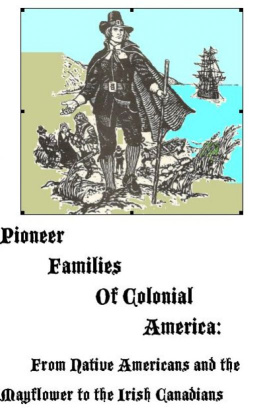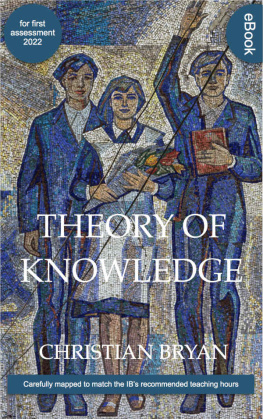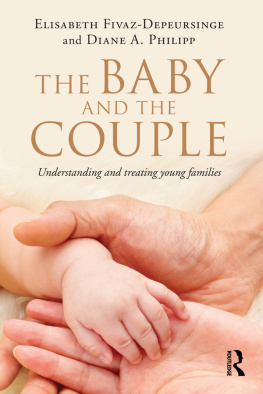First published 2006 by Paradigm Publishers
Published 2016 by Routledge
2 Park Square, Milton Park, Abingdon, Oxon OX14 4RN
711 Third Avenue, New York, NY 10017, USA
Routledge is an imprint of the Taylor & Francis Group, an informa business
Copyright 2006, Taylor & Francis.
All rights reserved. No part of this book may be reprinted or reproduced or utilised in any form or by any electronic, mechanical, or other means, now known or hereafter invented, including photocopying and recording, or in any information storage or retrieval system, without permission in writing from the publishers.
Notice:
Product or corporate names may be trademarks or registered trademarks, and are used only for identification and explanation without intent to infringe.
Library of Congress Cataloging-in-Publication Data
Starbuck, Gene H.
Study guide to accompany Families in context / Gene H. Starbuck.2nd ed.
p. cm.
ISBN-13: 978-1-59451-199-8 (pb)
ISBN-10: 1-59451-199-3 (pb)
1. FamilyExaminations, questions, etc. 2. FamilyProblems, exercises, etc. 3. Family
United StatesExaminations, questions, etc. 4. FamilyUnited statesProblems, exercises,
etc. I. Starbuck, Gene H.
Families in context. II. Title.
HQ728.S79 2006b
306.85076--dc22
2006012894
ISBN 13 : 978-1-59451-199-8 (pbk)
Chapter Outline
The Thinking Ahead and Rethinking in Context questions from the text are reproduced here. Chapter outlines offer an overview of the structure and emphasis of the chapter. Students might want to read the Learning Objectives and Chapter Outline before actually reading the textbook chapter.
Multiple Choice Questions, True/False Questions, Matching Question
Students can use these to test their mastery of the material. They should probably ask the instructor whether any of these questions will be on the actual test.
Short Essay, Critical Thinking, and Group Discussion Exercises
The essay and critical thinking exercises help develop writing, organizational, and analytical ability. The short essay questions can be answered with reference to material in the textbook. The critical thinking questions often require reference to outside sources such as Internet sites. Group discussion exercises are designed for discussion by students in small groups that might be arranged by the course instructor.
Answer Key
The answer key includes correct responses to objective questions and outlines the major points of the short essay questions.
Survey of Opinions and Experiences
The study guide concludes with a questionnaire about attitudes and experiences related to the family. Even if your instructor does not ask you to complete the questionnaire, you might look it over anyway. It will give you an idea about how survey questions are sometimes constructed. Most of these questions are from the General Social Survey, which provides much of the data reported in the text.
Learning Objectives
After reading this chapter, you should be able to
Understand the complexities of defining family and be able to describe various family forms.
Discuss the criteria for constructing definitions of family, including values and norms.
Outline the differences between structural and functional as well as macro and micro definitions of family.
Comprehend the case studies of Nayar and Israeli Kibbutz families as examples of alternative family forms.
Describe and apply Webers concept of ideal type to family systems.
Discuss gender in families as it relates to authority, power, inheritance, and residence.
Apply Moneys typology of gender roles.
Explain both pessimistic and optimistic outlooks for the family decline debate.
Chapter Outline
Thinking Ahead: Write a definition of the family. Make sure that your definition includes all those groups of persons you think of as being a family, while ruling out all groups that you think do not constitute a family.
1) Basic Considerations
a) What is family?
i) Nuclear
ii) Conjugal unit
iii) Extended family
iv) Family of orientation
v) Family of procreation
vi) Stepfamily
vii) Household
2) Criteria for Judgments
a) Values
b) Norms
i) Informal norms
ii) Formal norms
iii) Roles and scripts
c) Types of definitions
i) Functional definitions
(1) Microfunctional
(2) Macrofunctional
ii) Structural definitions
d) Defining marriage
e) Alternative families elsewhere
i) Nayar
ii) Israeli kibbutz
3) Ideal Types, Dichotomies and Continua
4) Gender
a) Authority
b) Descent and inheritance
c) Residence patterns
d) Gender role continuum
e) Types of gender roles
i) Sex-irreducible gender roles
ii) Sex-influenced gender roles
iii) Sex-arbitrary gender roles
5) The Family Decline Debate
a) The pessimistic position
b) The optimistic position
i) Glad it changed optimists
ii) Did not really change optimists
Rethinking in Context: Reconsider your initial definition of the family. Did it include all groups you had in mind? Did it exclude groups you do not think of as families? What values and norms are reflected in your definition? Was your definition more functional or more structural?
Ask five acquaintances to tell you about their families. What roles do they identify as part of their families? What kind of families did they describe?
Where do you stand on the family-decline debate? Why? What additional information would you need to be sure you are right?
Multiple Choice Questions
Susan and Trent are married to each other but have no children. They may be considered a(n)
a. Extended family
b. Conjugal unit
c. Nuclear family
d. Family of procreation
James lives with his biological father and his sister and brother. This is referred to as his
a. Family of procreation
b. Family of orientation
c. Stepfamily
d. Extended family
Kate and Liz have been partners for ten years and recently they adopted a child. Kate and Liz would call this their

